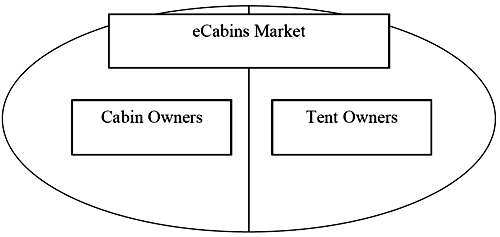Industry & Market Analysis
TARGET MARKETS
Owners and Online Commercial Customers
eCabins' target market is made up of owners of tent-cabins and online commercial customers interested in renting or staying in those tent-cabins.
Currently, there are approximately 970,000 operating tent-cabins in the US, with another 600,000 tentcabins in development.

Figure 2: eCabins' target markets consist of owners of tent-cabins and online commercial
customers interested in renting or staying in those tent-cabins.
TENT-CABINS: A HIGH GROWTH INDUSTRY
Tent-cabins are usually upscale, full-service developments focused in the strongest cabin markets: either popular vacation destinations, or in large cities where suburbanites frequent cabins for business or leisure purposes. Most buildings consist entirely of tent-cabin rooms and in some cases a combination of conventional and tent-cabin rooms.
The tent-cabin industry started in the 1980s in Florida with the development of the first tent-cabin buildings. Since 2002, the number of tent-cabin buildings in the US has grown rapidly from 12 to the current national total of approximately 100.
The industry has also expanded geographically, having moved beyond Florida in to major US centers, as well as Europe, Canada, South America, the Caribbean and the Middle East.
This growth in tent-cabins is reflected in the number of developers, now totaling over 850. The industry is expected to continue to grow, with approximately 30,000 tent-cabins currently under development.

Source: tentcabincenter.com
Figure 3: The number of tent-cabin buildings in the US has risen dramatically since 2002.
EXCESS DEMAND IN THE CONVENTIONAL CABIN INDUSTRY
There are not enough conventional cabin rooms to meet demand because of lack of supply. Construction of conventional cabin rooms has slowed due to rising costs. Post-Katrina rebuilding and Asian demand for steel and concrete have driven up costs for materials, while the real estate boom has raised land prices. The supply of new conventional cabin rooms is the tightest since the early 1990s.
Hence, the economics of conventional cabin construction have created a win-win situation for tent-cabins. Due to rising construction costs, tent-cabins often represent the easiest way to finance a project – hence the explosion in tent-cabin room construction. These higher construction costs are also slowing down development of conventional cabin rooms, creating a shortage of conventional cabin rooms and excess demand that cabin tent rooms can absorb. There are approximately 144,000 total cabin tent-cabins) under development, of which 160,000 rooms, or 27%, are tent-cabins.
ONLINE TRAVEL BOOKING
Travelers' use of the Internet to plan and book their trips continues to grow. The number of Americans who use the Internet for travel planning is approximately 70 million annually. From that group, about 50 million people book airline tickets, cabin rooms and other travel services online.
According to the Travel Industry Association of America, airline tickets are the most frequently purchased travel products on the Internet, with over 80% of all online travel bookers purchasing them. Accommodations are second, with approximately 70% of all online travel bookers making such purchases. Online travel bookers spend an average of approximately $3,000 each in purchases per year.
The Internet has also become a powerful marketing tool for the travel industry. Approximately 40 million online travelers have signed up with a travel supplier website or online travel service to receive email offers and promotions. In addition, over 11 million online travelers say they have taken a trip they otherwise would not have taken based on an emailed travel promotion, discount or offer.3

Figure 5
3 Travel Industry Association of America







